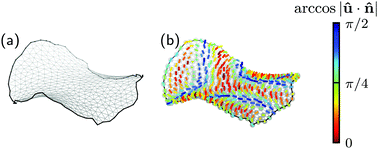Deformation and orientational order of chiral membranes with free edges
Abstract
Motivated by experiments on colloidal membranes composed of chiral rod-like viruses, we use Monte Carlo methods to simulate these systems and determine the phase diagram for the liquid crystalline order of the rods and the membrane shape. We generalize the Lebwohl–Lasher model for a nematic with a chiral coupling to a curved surface with edge tension and a resistance to bending, and include an energy cost for tilting of the rods relative to the local membrane normal. The membrane is represented by a triangular mesh of hard beads joined by bonds, where each bead is decorated by a director. The beads can move, the bonds can reconnect and the directors can rotate at each Monte Carlo step. When the cost of tilt is small, the membrane tends to be flat, with the rods only twisting near the edge for low chiral coupling, and remaining parallel to the normal in the interior of the membrane. At high chiral coupling, the rods twist everywhere, forming a cholesteric state. When the cost of tilt is large, the emergence of the cholesteric state at high values of the chiral coupling is accompanied by the bending of the membrane into a saddle shape. Increasing the edge tension tends to flatten the membrane. These results illustrate the geometric frustration arising from the inability of a surface normal to have twist.



 Please wait while we load your content...
Please wait while we load your content...